Time is up with our bells-and-whistles electric exec. How did it fare?
Before this BMW i5 Touring arrived, I’d spent some time looking after a Land Rover Defender. The two are about the same price, at approximately £100,000 – and, no, I don’t know how so many people appear able to afford cars of that value either.
But to run them as company cars would be quite a different experience. The Defender came with a 3.0-litre diesel engine, thus attracting a 37% benefit-in-kind tax rating – so an employee would pay tax on nearly £37,000 annually; a 40% taxpayer would be faced with a monthly tax bill of nearly £1200.
Compare and contrast with this new BMW i5 Touring and its 2% benefit-in-kind rating, which would leave a 40% taxpayer with a bill of just £67 a month to run it.
The difference is of the magnitude that I keep going back to check it’s not wrong. It’s no wonder that EVs or long-electric-range plug-in hybrids are today the go-to cars for company users.
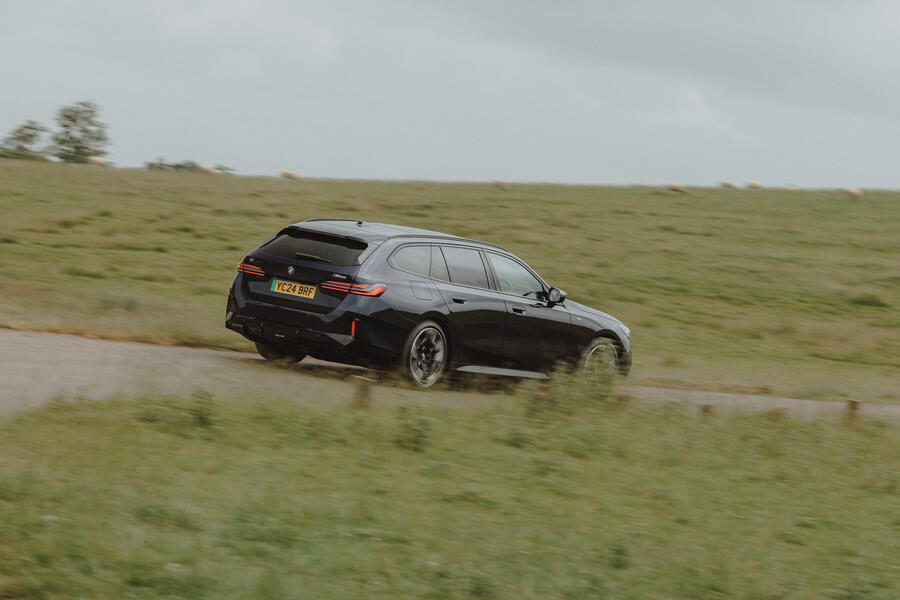
Anyway, a near-six-figure purchase price before options gets one into a significant amount of electrified BMW hardware. The 5 Series Touring is a big estate car these days, at 5060mm long and 1900mm wide across the body, and it has a 2995mm wheelbase. There’s lots of shared BMW 7 Series architecture underneath it.
This is as plush as 5s get, arriving with us as it did in M60 xDrive form. It’s four-wheel drive courtesy of two motors and has 592bhp in total, so it can go from 0-62mph in a claimed 3.9sec. It’s a figure I can entirely believe: I recommend a cup with a fully closable lid for one’s morning commute tea.
Like less oomphy 5s this one comes with an 81.2kWh battery, which, owing to the car’s stonking performance and 2425kg weight, means it won’t go quite so far as lower-powered single-motor 5s on a charge: its combined WLTP range is 310 miles and energy consumption is 3.3mpkWh. It can charge up at 205kW. Although, in my early experience, you won’t be surprised to learn, it won’t routinely match all of those figures.
It does come pretty well equipped as standard, and there are 10 colours to choose from, nine of them metallic, including a red, a blue and a green as well as obligatory monochromes, before you would have to spend a bean for something else. This one is the £1095 Tanzanite blue.
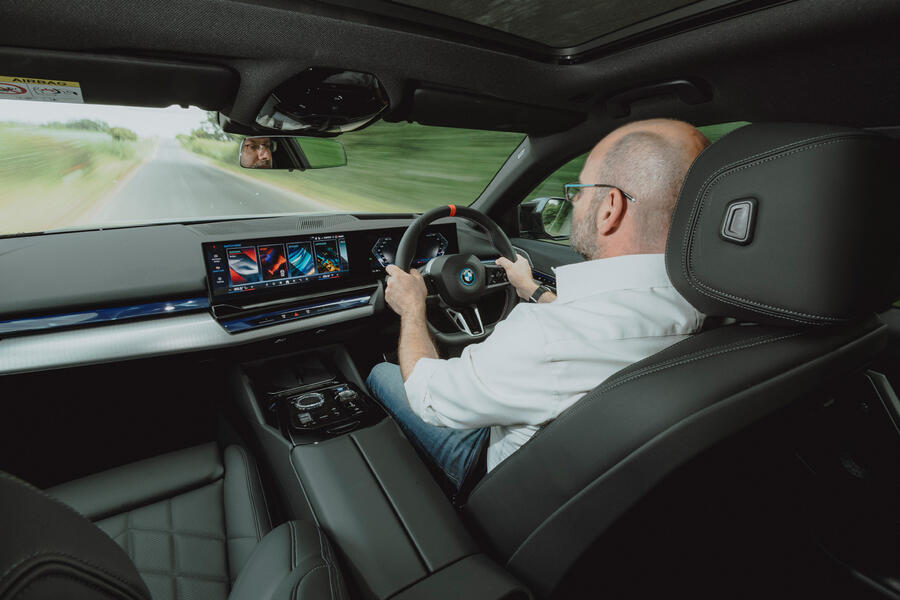
The M60 comes with an M Sport Pro package too, most significantly including uprated brakes, with the rest of it cosmetic. Other standard equipment includes Bowers & Wilkins audio, and I suspect one would be pretty content with it.
To this example, though, a few packages have been added. M Adaptive Suspension Pro costs £4000 and comes with adjustable damping. The Technology Plus pack (£3300) has a head-up display plus parking and driving assistant functions that I must spend more time getting used to, including whatever ‘BMW Natural Interaction’ is.
Then there’s a Comfort Plus pack, a £3350 combination of heated rear as well as front seats, ventilated front seats and, one of my favourite things on cooler mornings, a heated steering wheel.
That brings the total on-the-road cost of this car to £116,060, but if you didn’t spec all of that, I don’t think you’d feel like you’d missed out: the lush upholstery, silvery interior highlights and 20in wheels all come as standard.
Throw in the broad colour range too, and, well, it turns out that a £100k car isn’t exactly poverty spec, unsurprisingly.
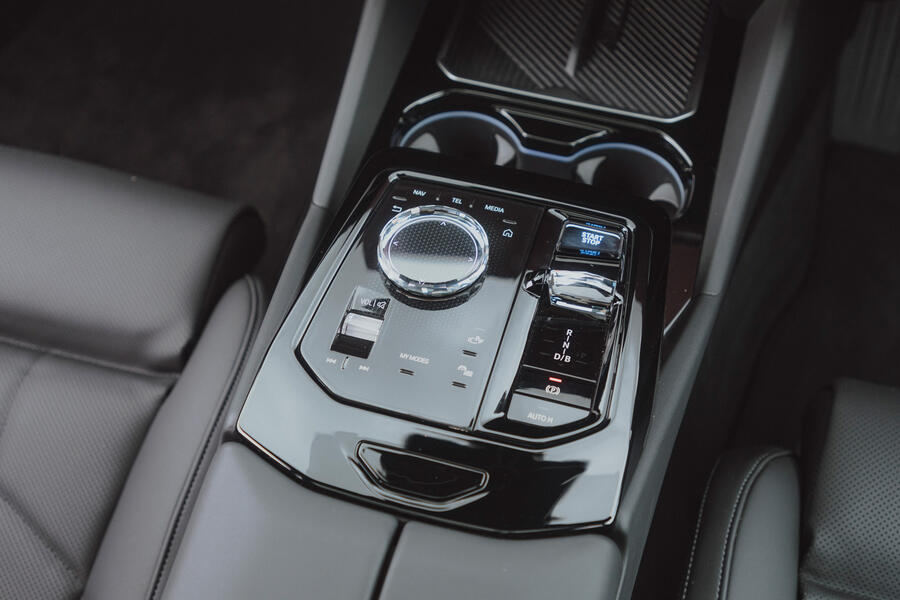
Some of our testers say they prefer the lesser i5s to this all-singing, all-dancing* (*may not sing or dance) top-spec M60 model, owing to their lighter weight and what to them feels like a more compliant ride. I can understand that, and although I haven’t spent much time in various 5s, when I drove a couple of i7s I came away from them feeling the same way.
But I have very quickly got into the i5 M60’s groove, and it doesn’t feel like it’s short-changing me on comfort.
At some point I’d like to try a back-to-back test with an M40, but still, while it’s for very clear reasons not as absorbent as the Defender I rolled around in before, the BMW casts surface imperfections aside well enough, plus it comes with the advantage of a much smaller frontal area and a considerably lower centre of gravity, making it a much more dynamic road car.
The steering is smooth and accurate and medium-heavy of weight, and while this is still a big car with a hefty kerb weight, it disguises both pretty well.

I’m finding it a little easier to park than the Land Rover owing to the reduced size and active-rear steering, but with smaller mirrors it’s not necessarily easier to place in a bay – it’s just simpler to find one in which it fits (although if, like me, you prefer to park in an end bay, scooched as far away from other cars – and their drivers – as is possible, you’ll know there’s still often some searching to it).
Since the nippers have left home I’m not using all of the car’s practicality as much as I used to, but I have had some rear-seat passengers who tell me it’s pretty nice back there: it’s always a treat for them to find rear seat heating, I find.
The boot is big, too, and let down only by the fact that the 5 doesn’t get a separately opening glass hatch these days. I’d give up a few of the other options to have retained that, but it’s one of few early gripes with this car, which is otherwise settling into the Autocar fleet very nicely.
Update 2
As I write this, driving impressions of the new BMW M5 saloon have just landed. You might have heard some rumblings about the kerb weight of the latest M car, which in Touring estate form will be 2550kg, although that includes a 90%-full fuel tank and a 75kg driver.
Incidentally, one of the things we have to be careful about in this business is manufacturers that prefer to quote weights without that allowance; aren’t quite specific about it; hide it away somewhere; or quote that annoying dry weight instead, as if a car will work without oil, petrol and, oh, I don’t know, screenwash.
Anyway, bravo to BMW for making it very clear what the M5 weighs, when the temptation must have existed to not be quite so obvious about it. But what it does mean is that the new M5 Touring is 125kg heavier than even my fully electric i5 Touring, which is itself pretty hefty, at 2425kg.
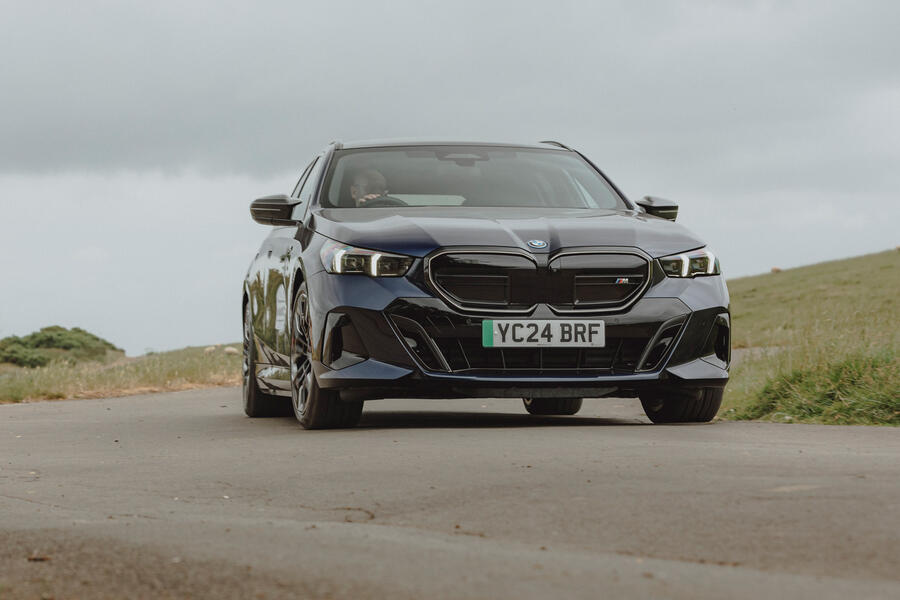
But I come not to bury BMW. It will have done its best, and it won’t want its cars to carry extra kilos any more than you or I do. It’s just that an M5 is meant to do everything all at once, which means it must have an electric motor yet also an engine, because BMW thinks the world isn’t quite ready for a fully electric M5 yet. Given how and where some are used, I think that’s probably true.
And yet, I like V8s as much as the next man, even if the next man is Keith Duckworth, but here’s a thing: having now spent some weeks getting into the groove of the new 15 Touring, in this M-but-not-really M M60 ×Drive specification, I’ve started to wonder what it would be like if this EV had been given the full M treatment.
I’m not pretending 2425kg isn’t a lot. But already that’s a 125kg advantage over the M5. There’s clearly a limit to how much lighter it could become (a battery is a battery and one wouldn’t want it smaller than its 81kWh), but by the time there were manual seats, a carbonfibre roof and trim bits and bonnet, lightweight glass and doors and perhaps a boot that one had to open manually and they had thrown out some other things that would be expected on an M60 but not on an iM5, where could it land? 2200kg?
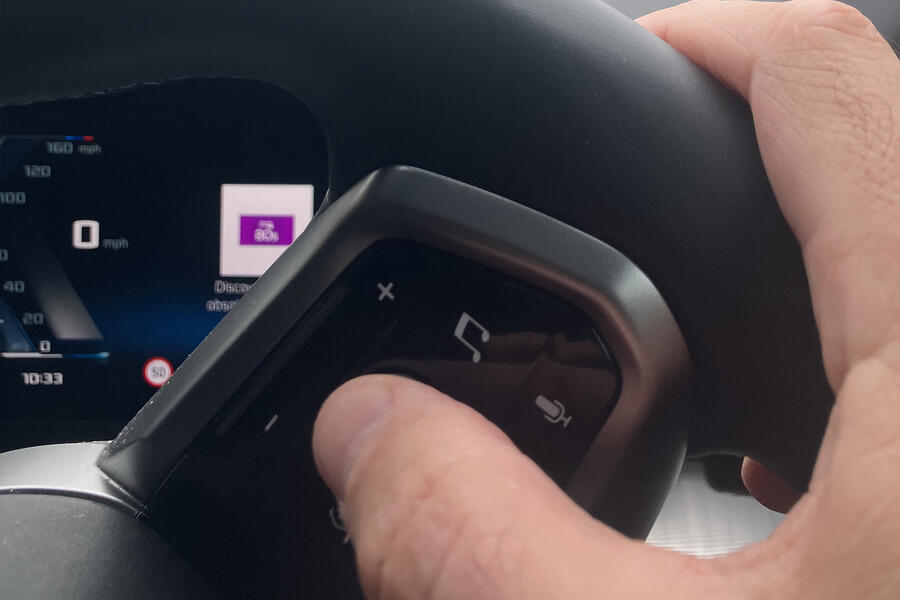
That would be Hyundai loniq 5 N territory, and we know what a good car that is. And in a couple of years, when a new generation of batteries arrives, perhaps one could have a weight starting with a one again.
I suppose BMW would want it to have more than this car’s 592bhp, but it wouldn’t really need it, and then M could go at the ride and handling, giving it fancy torque vectoring and tuning some very trick suspension. And that might amend one of the things our testers were a bit lukewarm about with this M60: that the ride wasn’t polished enough and the body control was sometimes too loose.
Perhaps I’m getting mellower as I age, but those things bother me less. I really like this car. The secondary ride of the M60 isn’t as isolated as lesser i5 variants’, it’s true, but my only significant concern about that comes when I spot crumbling road edges, and I’m then more concerned for the wheel and tyre than my discomfort.
I’m more troubled by primary body control, which while fine on good roads is more easily thrown on back roads, where the dips and crests can leave the body heaving and wanting a moment to settle.
It’s only then that I’m really aware how much heft the i5 is carrying, like an ICE car that’s fully laden, and it’s in these moments that I wonder what it would be like if it could be shorn of a few pounds.
It’s a big car, and for the most part I’m still discovering what a satisfying one it is too. But (and I’m sure BMW is thinking it too) I’m also wondering what it could become.
Update 3
The i5 pings me quite a lot of messages. Recently it had been telling me the tyres were a little underinflated because the weather had been getting cooler, but that I didn’t need to worry about it.
They’re meant to be at 2.6 or 2.7 bar (38-39psi) both front and rear and in the summer they were. As autumn came that slipped to 2.4 bar (35psi), but as I drive mostly alone and with the car unladen, running at under fully laden pressures was no big deal.
The car agreed. I figured it improved the ride, too, which was no bad thing: this sometimes gets used as a car-to-car tracking photography vehicle, most recently at Gordon Murray Automotive for a story coming soon (and a podcast out now), so every bit of smoothness helps with photo sharpness.
Moreover, I’d been leaving them as they were as an experiment. Steve Cropley told me last year what a difference temperatures had made to the pressures on his Dacia Duster, and I wanted to see what difference cooling weather made to these.
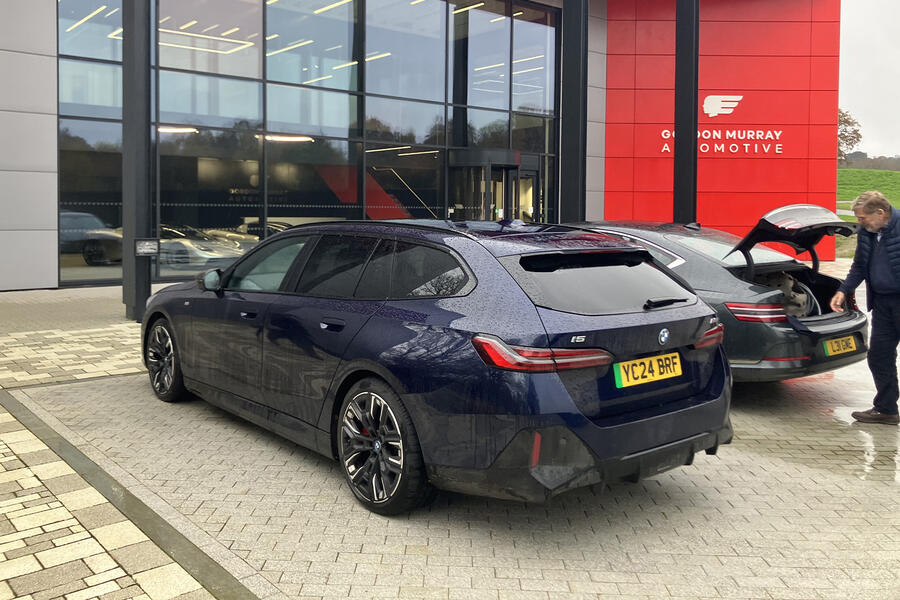
But this week it got so cold that the BMW and I agreed I really should now pump up the tyres. In freezing conditions they fell rapidly from 2.4 to a little over 2.1 bar.
That’s still 30psi, so not sufficiently low that you would worry in most cars, but the i5 is heavy, so it requests relatively high pressures. So I went to top them up, with a final experiment on the way.
On my way up a quiet road, I tried accelerating and braking to get a bit of heat into the rubber and see what difference it made to the pressure. I increased the tyre temperature by 8°C, which added about 2psi (0.1 bar). Still significantly lower than they had been until very recently.
As well as comfort, I’ll see what difference, if any, the higher pressures make to the car’s efficiency, which has also taken a rapid dive in recent cold weather.
I was getting a consistent 250 miles – plus or minus 10 miles or so – from a 100% charge, from the summer until just a few weeks ago. But in freezing weather that has slipped to around 210 miles.
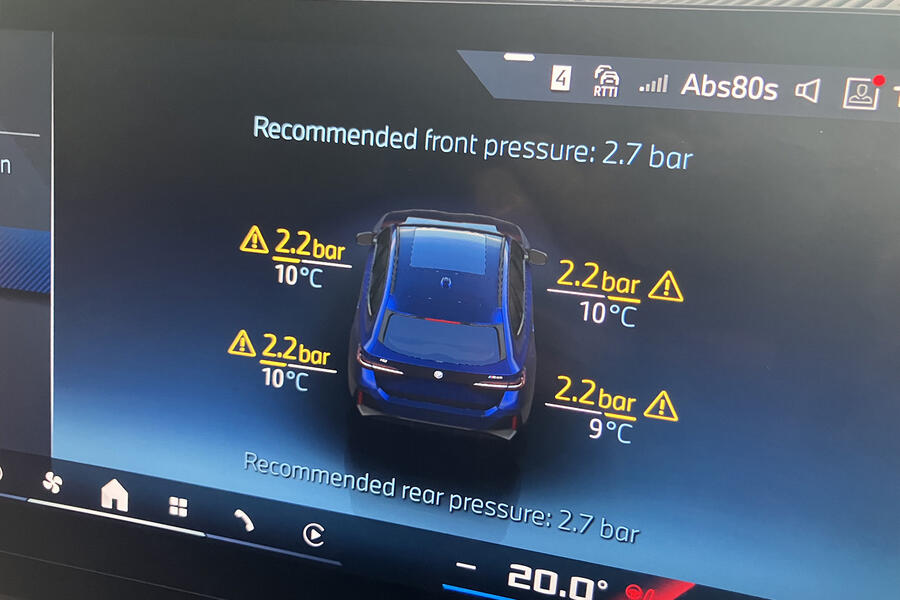
This week I went from Bicester to the office in Twickenham, then to the British Motor Museum at Gaydon, and back home via the gym and shops (201 miles in all), with several stops (unhelpful because the battery goes cold each time), and arrived home with 4% charge left.
I know the score with battery response to temperatures and the optimism of WLTP figures and so on, but there are buyers who don’t, and when they see an i5 advertised with ‘up to 310 miles’ of range, one wouldn’t imagine they’d be thrilled to only get two-thirds of that if the weather’s sufficiently cold and the journey at speed and/or stilted.
I’ll see what difference more air in the tyres makes, first at recommended pressures then maybe slightly higher ones, plus I’ll stick it into Efficiency mode and back off on some long journeys before I really criticise it. But I’m not expecting miracles.
Everything being electric, mind, the car does warm through quickly from standstill. In a combustion car whose water needs heating, it’s several minutes before the chill comes off the interior. The BMW is warm before I’ve finished driving up the road I live on. Swings and roundabouts.
Update 4
Autocar’s time with this electric 5 Series estate is running out, but I’m still discovering things about it. That’s partly because it has a plethora of features, partly because its efficiency varies a lot.
Given that I spent a lot of time last year in a Ford Ranger Raptor, whose petrol V6 returned 21-23mpg consistently regardless of how I treated it, gamifying what efficiency the i5 can return has been fun in a test car. It could be as an ownership proposition too, but there are times when that novelty might wear off.
The other day, I drove from north Oxfordshire to south Hampshire to visit my folks, then did a little local running around, taking it gently because I didn’t feel like charging on the road.
Still, on the way back I found myself in the sort of quandary that EV drivers with home charging capability will know: to stop or not, with a predicted remaining range falling faster than the actual miles.
It was late, dark and chilly if not as cold as when it snowed and the car obliged with 213 miles, or 2.6mpkWh, from 100%) and fast chargers are expensive.
If I’d backed off, I’d probably have reached home, by slipstreaming a coach or truck if things had become critical. Or I could have carried on driving at the speed limit and taken five minutes for a ‘splash and dash’.
That would probably have taken a few minutes longer than plodding on. The battery would have needed only a tickle to confidently get me home. I’d have been in the cold while plugging in, but I’d have had time to buy sweets and drive faster after.
A bit nervy, I caved and stopped at the pricey Shell chargers at Tot Hill services, plugged in, checked it was working, strolled into the shop, came back out and found the charge had failed. Blast. I think the cable was too taut. It was the worst of both worlds: taking the time to stop for no reward.
I was too cross to try again, so I drove off and took it easy, drafting a coach for a while and returning home with 5% remaining.
So I managed 3.2mpkWh that day, consuming 81KWh of energy and a bag of Haribo per 261 miles.
Final update
The BMW i5 Touring has returned to its maker, having spent several months on the Autocar fleet in my custody. A time that has been almost entirely pleasurable.
To recap, the i5 is an electric version of BMW’s 5 Series Touring, once (perhaps still) the archetypal big executive wagon. Bigger than ever, in fact, at more than 5.0 metres long and 1.9m wide, and with a lot of architecture that’s common between 5 and 7 Series BMWs.
In making the car electric, BMW has fitted it with 81.2kWh of (usable) battery, and because this is the M version, it has 592bhp deployed through all four wheels. That’s enough to give it a 0-62mph time of 3.9sec and a top speed, although I didn’t get near trying it, of 143mph.
As a result of the hardware, it’s heavy, at 2425kg – but that is still lighter than the latest M5 Touring. But while it says M in the name, has nearly 600bhp and acceleration figures that would have stolen many a Top Trumps hand only a few years ago, this car is very much 5 Series first and an M car only in passing.
It’s basically a fast and largely painless luxury estate that is big on features and pretty tidy when it comes to being comfortable. Well, I’ve come to think it has the luxury blend about right. Some of our earlier first drives felt that the rolling comfort of the M60 wasn’t quite isolated enough, but familiarity can do strange things to you.
Across 12,000 miles during our time together, the i5 has coaxed me into its way of thinking when it comes to dealing with road lumps and bumps: I know which potholes to drive around and what the ideal attack speed is for local speed humps.
On more accommodating rubber than its low-profile Pirelli P Zeros, I’m sure it would be more compliant, and if I was asked to recommend or spec up an i5, I might well advise more tyre sidewall. But I didn’t find this dynamic specification a drag, and no passenger ever said it was too firm.
Nor, though, should you think of it as a real driver’s car. I was frequently glad it has a low driving position and a smaller frontal area than an SUV, and with a low centre of gravity it doesn’t roll much either. The steering is quick and accurate, too, and the throttle response is terrifically well judged.
But it’s not engaging or interactive; it’s the kind of car that you just subconsciously think into place. I can’t remember the way it drives annoying me, but I haven’t had a memorable drive in it, either. A few years ago I ran a Polestar 2 and still recall one B-road thrash on which it seemed to get better as the dampers got warmer.
The BMW is a better and preferable car, but it’s quietly effective rather than overtly charismatic. The i5 just melted into daily driving, whether that’s town, motorway or B-road.
Using certain features became habits: on start-up I’d press a centre console button and then two on the touchscreen to disable lane assist and traffic sign reading (although the latter didn’t stop it occasionally telling me I was driving the wrong way down one particular street, incorrectly and infuriatingly).
And if I was slowly manoeuvring forwards but wanted better visibility, I learned to flick the drive selector briefly into reverse and back to D again, which would pull up the all-round cameras.
Other ergonomics are a mix of great (the rotating dial on the steering wheel for the audio) and weird (remote, part-digital buttons for the air vents). What I could never quite work out is what car-locking routine would later give me keyless entry – and I usually locked it with the key fob at home because I plugged the car in most times I parked it.
Nothing went wrong, save the occasional reluctance to perform some CarPlay actions. It didn’t require servicing during its time with us, and I reckon the front tyres would have been good for up to 20,000 miles, the rears for longer.
The purchase price is high and the depreciation is steep, but the benefit-in-kind is incredibly low. To the other obligatory electric car mathematics, then, with the usual caveats about whether an EV is right for you (like winter tyres, you will probably know by now if it will suit you or not).
In warmer weather, I consistently got 250 miles or more out of the BMW’s battery, but that slipped notably when it was really cold. I did once or twice approach the WLTP range of 321 miles, which should be considered more like a slow-cruise, long-distance touring figure.
Could I have done better than my 240- to 260-mile average? Sure, but if an owner wants to drive slowly and use as little energy as possible, they are probably not going to be buying/leasing/whatever a 600bhp BMW in the first place.
Choose the i5, though, and what you’re getting is a dynamically capable, low and stable, fast and responsive and ultimately quite satisfying luxurious estate car.
BMW i5 M60 xDrive Touring specification
Prices: List price new £99,090 List price now £99,995 Price as tested £116,060
Options: M Adaptive Suspension Pro £4000, Comfort Plus pack £3350, Technology Plus pack £3300, sunroof £1600, towbar £1200, Tanzanite blue paint £1095, carbon exterior styling £920, clarity controls £600
Fuel consumption and range: Claimed range 321 miles Battery size 83.9/81.2kWh (total usable) Test average 3.2mpkWh Test best 3.9mpkWh Test worst 2.6mpkWh Real-world range 257 miles Max charge rate 205kW
Tech highlights: 0-62mph 3.9sec Top speed 143mph Engine Two permanent magnet synchronous motors Max power 592bhp Max torque 586lb ft Transmission 1-spd reduction gear, 4WD Boot capacity 570-1700 litres Wheels 8.5Jx20in, alloy Tyres 245/40 R20 (f), 275/35 R20 (r), Pirelli P Zero Kerb weight 2425kg
Service and running costs: Contract hire rate £1032pcm CO2 0g/km Service costs None Other costs None Fuel costs £1022 Running costs inc fuel £1022 Cost per mile 8 pence Faults None
Source: Autocar